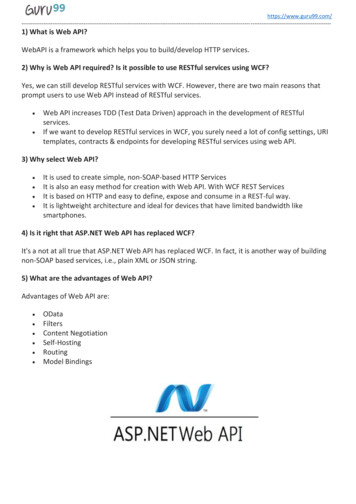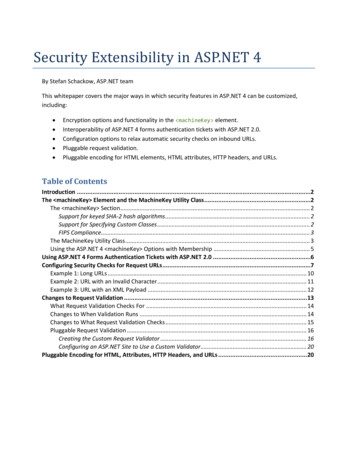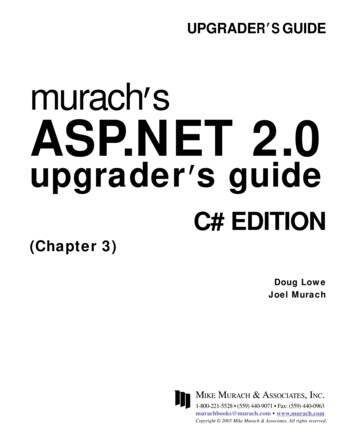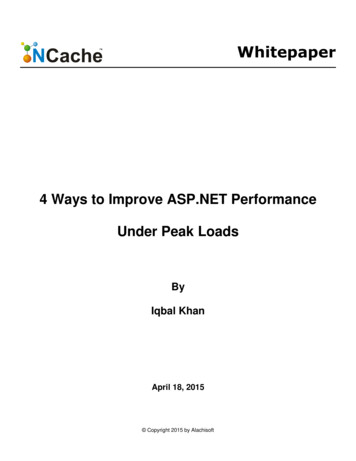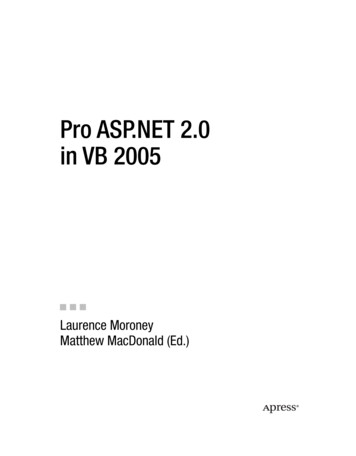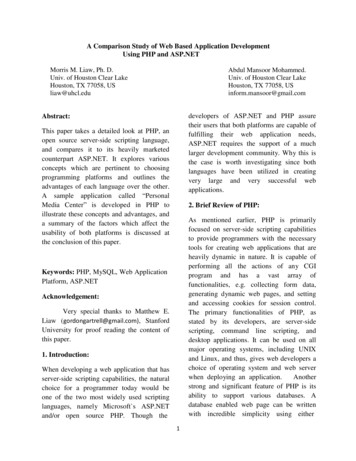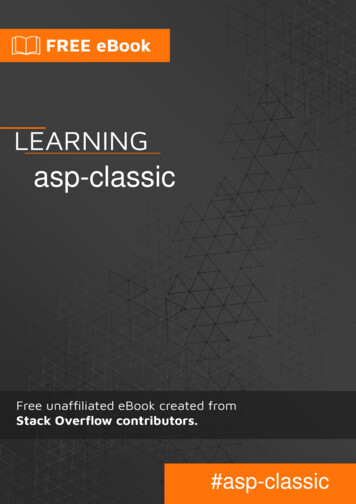
Transcription
asp-classic#asp-classic
Table of ContentsAbout1Chapter 1: Getting started with asp-classic2Remarks2Versions2Examples2Hello World2Structure of a Simple ASP Page3Chapter 2: Connecting to a database4Introduction4Examples4Populating a dropdown from the databaseChapter 3: Looping45Examples5For Loop5Do Loop5Chapter 4: VariablesExamples77Declaring7Variable Types7Credits9
AboutYou can share this PDF with anyone you feel could benefit from it, downloaded the latest versionfrom: asp-classicIt is an unofficial and free asp-classic ebook created for educational purposes. All the content isextracted from Stack Overflow Documentation, which is written by many hardworking individuals atStack Overflow. It is neither affiliated with Stack Overflow nor official asp-classic.The content is released under Creative Commons BY-SA, and the list of contributors to eachchapter are provided in the credits section at the end of this book. Images may be copyright oftheir respective owners unless otherwise specified. All trademarks and registered trademarks arethe property of their respective company owners.Use the content presented in this book at your own risk; it is not guaranteed to be correct noraccurate, please send your feedback and corrections to info@zzzprojects.comhttps://riptutorial.com/1
Chapter 1: Getting started with asp-classicRemarksActive Server Pages (ASP), also known as Classic ASP or ASP Classic, was Microsoft's firstserver-side script-engine for dynamically-generated web pages. The introduction of ASP.NET ledto use of the term Classic ASP for the original technology.The default server-side scripting language for ASP is VBScript. The generated pages are meant tobe viewed in a browser, so they usually use HTML markup and CSS styling.1ASP is not installed by default on these versions of IIS. You need to go into the server manager features and addASP.See Classic ASP Not Installed by Default on IIS 7.0 and Hello World !doctype html html head title Example Page /title /head body %'This is where the ASP code begins'ASP will generate the HTML that is passed to the browser'A single quote denotes a comment, so these lines are not executedhttps://riptutorial.com/2
'Since this will be HTML, we included the html and body tags'for Classic ASP we use Response.Write() to output our text'like thisResponse.Write ("Hello world")'Now we will end the ASP block and close our body and html tags% /body /html When response is sent from the Server to the Browser the output will be like this: !doctype html html head title Example Page /title /head body Hello world /body /html Structure of a Simple ASP Page %@ Language "VBScript" CodePage 65001 % %Option ExplicitResponse.Charset "UTF-8"Response.CodePage 65001% !doctype html html head title My First Classic ASP Page /title /head body % "Hello World"% /body /html This is a very basic example of a Classic ASP page that returns the phrase "Hello World" to thebrowser along with the rest of the standard HTML. The HTML portions are static, i.e. the serverwill send them to the browser as-is. The parts delimited by % % are what the server will actuallyprocess before sending it to the client.Note that the % "stuff"% syntax is shorthand for %Response.Write"stuff"% .Read Getting started with asp-classic online: m/3
Chapter 2: Connecting to a databaseIntroductionClassic ASP utilises a technology called ActiveX Data Objects when requiring access to externaldata sources. The ADODB Library provides three main objects for this purpose, ADODB.Connection,ADODB.Command and the ADODB.Recordset.ExamplesPopulating a dropdown from the database(Caveat emptor: there are many, many programmers who go into absolute conniptions if theymeet code that uses recordsets instead of commands and stored procedures.) %dim rs, sqldim SelectedUserSelectedUser request.form("user")if IsNumeric(SelectedUser) thenSelectedUser CLng(SelectedUser)elseSelectedUser 0end if% . p Select a user: select name "user" size "1" %sql "SELECT id, displayname FROM users WHERE active 1 ORDER BY displayname"set rs server.createobject("ADODB.Recordset")rs.open sql,"[connection string stuff goes here]",1,2do until rs.eofresponse.write " option value '" & rs("id") & "'"if rs("id") SelectedUser then response.write " selected"response.write " " & rs("displayname") & " /option " & vbCrLfrs.Movenext ' - VERY VERY IMPORTANT!looprs.closeset rs nothing% /select /p .Read Connecting to a database online: necting-toa-databasehttps://riptutorial.com/4
Chapter 3: LoopingExamplesFor LoopIn classic ASP we can specify a for loop with the for keyword. With the for statement we need thenext statement which will increment the counter.For i 0 To 10Response.Write("Index: " & i)NextThe step keyword can be used to changed the how the next statement will modify the counter.For i 10 To 1 Step -1'VBS CommentNextTo exit a for loop, use the Exit For statementFor i 0 To 10Response.Write("Index: " & i)If i 7 Then Exit For 'Exit loop after we write index 7NextWe can also use a For.Each loop to perform a loop through a series of defined elements in acollection. For instance:Dim farm, animalfarm New Array("Dog", "Cat", "Horse", "Cow")Response.Write("Old MacDonald had a Farm, ")For Each animal In farmResponse.Write("and on that farm he had a " & animal & ". br / ")NextDo LoopDo while is very similar to for loop however this generally is used if our loop repetitions isunknown.Do While:'Continues until i is greater than 10Do While i 10i i 1Loop'Or we can write it so the first loop always executes unconditionally:https://riptutorial.com/5
'Ends after our first loop as we failed this condition on our previous loopDoi i 1Loop While i 10Do Until:'Ends once i equates to 10Do Until i 10i i 1Loop'Or we can write it so the first loop always executes unconditionally:'Ends after our first loop as we failed this condition on our previous loopDoi i 1Loop Until i 10Exiting a Do loop is similar to a for loop but just using the Exit Do statement.'Exits after i equates to 10Do Until i 10i i 1If i 7 Then Exit DoLoopRead Looping online: pinghttps://riptutorial.com/6
Chapter 4: VariablesExamplesDeclaringCreating variables in VBScript can be done by using the Dim, Public, or Private statement. It isbest practice to put at the top of the script "Option Explicit" which forces you to explicitly define avariable.You can declare one variable like this:Option ExplicitDim firstNameOr you can several variables like this:Option ExplicitDim firstName, middleName, lastNameIf you do not have the option explicit statement, you can create variables like so:firstName "Foo"This is NOT recommended as strange results can occur during the run time phase of your script.This happens if a typo is made later when reusing the variable.To create an array, simply declare it with how many elements in the parameter:Option ExplicitDim nameList(2)This creates an array with three elementsTo set array elements, simply use the variable with the index as parameter like so:nameList(0) "John"VBScript also supports multi-dimensional arrays:Option ExplicitDim gridFactors(2, 4)Variable TypesVBScript is a weakly typed language; variables are all of type variant, though they usually have anhttps://riptutorial.com/7
implied subtype denoting the data they hold.This means that your variable, no matter what you call it, can hold any value:Dimfoofoofoofoofoo "Hello, World!" 123.45 #01-Jan-2016 01:00:00# TrueNote that the above is perfectly valid code, though mixing your variables like this is amazingly poorpractice.The string subtype is always assigned by using speech marks " ". Unlike JavaScript and otherlanguages, the apostrophe does not provide the same functionality.Numbers in VBScript can include any format of number, but do have a particular subtype based ontheir value and whether they contain a decimal point or not.Dates use the # # specifiers. Be aware that formats for a numeric date style (e.g. 01/01/2016)retains an American date format, so #05/06/2016# is 6th May, not 5th June. This can becircumnavigated by using a #dd-mmm-yyyy# format, as in the example above.Boolean variables contain True or False values.As explained earlier, arrays are dimensioned using a set of parentheses to define the number ofelements and ranks (rows and columns), for instance:Dim myArray(3, 4)All elements in arrays are of type variant, allowing every single element to be of any subtype. Thisis very important when you need to perform tasks such as reading data from a record set or otherobject. In these cases, data can be directly assigned to a variable, for instance, when beingreturned from a record set.Dim myData.myData )One final type that requires some explanation is the Object type. Objects are basically pointers tothe memory location of the object itself. Object types must be Set.Dim myObjSet myObj Server.CreateObject("ADODB.ecordSet")Read Variables online: iableshttps://riptutorial.com/8
CreditsS.NoChaptersContributors1Getting started withasp-classicCommunity, David Starkey, Lankymart, Martha, RamenChef,SearchAndResQ2Connecting to adatabaseLankymart, Martha3LoopingJake, Paul4Variablesfeetwet, Jake, John Odom, Lankymart, Paulhttps://riptutorial.com/9
from: asp-classic It is an unofficial and free asp-classic ebook created for educational purposes. All the content is extracted from Stack Overflow Documentation, which is written by many hardworking individuals at Stack Overflow. It is neither affiliated with Stack Overflow nor official asp-classic.



